- Dissolution Properties of Controlled Release Capsules Containing Quetiapine Fumarate
Pil Yun Kim, Jun Jae Jung, Nam Yeong Kim, Jin Woo Kim, Jeong Min Choi, Won Chan Lee, Jeong Eun Song, and Gilson Khang†

Department of BIN Convergence Technology, Department of Polymer Nano Science & Technology and Polymer Materials Fusion Research Center, Jeonbuk National University, 567 Baekje-daero, Jeonju 54896, Korea
- 쿠에티아핀 푸마르산을 함유하는 방출제어 캡슐제의 용해특성
전북대학교 BIN융합공학과, 고분자나노공학과, 고분자융합소재연구소
Quetiapine fumarate (QF) is a
BCS CLASS II with low solubility and high permeability, which has a problem of
low bioavailability. It has also been reported that Quetiapine possesses two
hydroxyl groups, so it has a higher solubility under acidic conditions. The
solubility is low in the range of pH 4 or higher and it is high
when pH is 2, and it decreases when the pH is lower than 2 which is due to ion
effect. Therefore, capsules were prepared using immediate-release and
sustained-release granules to improve the solubility of QF and induce constant
release even with a change in pH. XRD and DSC were used to evaluate the
crystallinity and inclusion of drugs, SEM was used for morphological analysis,
and FTIR was used to analyze chemical changes. In addition, fluidity was
evaluated to confirm that it was improved by granulation process. Finally, the
solubility patterns of solid dispersions and capsules were analyzed by a
solubility test.
쿠에티아핀 푸마르산(quetiapine
fumarate, QF)은 낮은 용해도와 높은 투과성을 갖는 BCS CLASS Ⅱ로 생체이용률이
낮은 문제가 있다. 또한 쿠에티아핀은 2개의 수산화기를 보유하여, 산성 조건 하에서 더 높은 용해도를 갖는다고 보고되어 있다. 즉, pH 4 이상의 범위에 대해서는 용해도가 낮고, pH 2에서 높은
용해도를 보이며, pH 2 미만에서는 이온 효과로 인하여 용해도가 감소한다. 따라서 QF의 용해도를 향상시키고
pH의 변화에도 일정한 방출을 유도하기 위해 속방 및 서방성 과립물을 이용한 캡슐을 제조하였다.
XRD와 DSC를 사용하여 약물의 결정성과 포접을 평가,
SEM을 통해 형태학적인 분석, FTIR 분석을 수행하여 화학적 변화를 분석하였다. 또한 습식과립공정을 통해 유동성이 개선된 것을 확인하기 위해 유동성 평가를 하였으며 최종적으로, 용해도 시험으로 고체 분산체 및 캡슐제의 용해도 패턴을 분석하였다.
Keywords: quetiapine fumarate, immediate release, sustained release, controlled release, rotary evaporation, spray dry solid dispersion
- Polymer(Korea) 폴리머
- Frequency : Bimonthly(odd)
ISSN 0379-153X(Print)
ISSN 2234-8077(Online)
Abbr. Polym. Korea - 2023 Impact Factor : 0.4
- Indexed in SCIE
 This Article
This Article
-
2020; 44(5): 715-724
Published online Sep 25, 2020
- 10.7317/pk.2020.44.5.715
- Received on May 27, 2020
- Revised on Jun 23, 2020
- Accepted on Jun 29, 2020
 Correspondence to
Correspondence to
- Gilson Khang
-
Department of BIN Convergence Technology, Department of Polymer Nano Science & Technology and Polymer Materials Fusion Research Center, Jeonbuk National University, 567 Baekje-daero, Jeonju 54896, Korea
- E-mail: gskhang@jbnu.ac.kr









 Copyright(c) The Polymer Society of Korea. All right reserved.
Copyright(c) The Polymer Society of Korea. All right reserved.